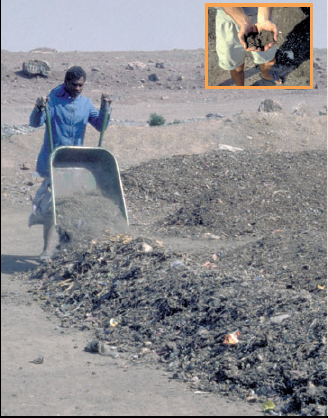Co-composting
|

|
|
| |||||||||||||||||||||||||||||||
Co-Composting is the controlled aerobic degradation of organics using more than one feedstock (Faecal sludge and Organic solid waste). Faecal sludge has a high moisture and nitrogen content while biodegradable solid waste is high in organic carbon and has good bulking properties (i.e. it allows air to flow and circulate). By combining the two, the benefits of each can be used to optimize the process and the product. For dewatered sludges, a ratio of 1:2 to 1:3 of dewatered sludge to solid waste should be used. Liquid sludges should be used at a ratio of 1:5 to 1:10 of liquid sludge to solid waste.
There are two types of Co-Composting designs: open and in-vessel. In open composting, the mixed material (sludge and solid waste) is piled into long heaps called windrows and left to decompose. Windrow piles are turned periodically to provide oxygen and ensure that all parts of the pile are subjected to the same heat treatment. Windrow piles should be at least 1m high, and should be insulated with compost or soil to promote an even distribution of heat inside the pile. Depending on the climate and available space, the facility may be covered to prevent excess evaporation and protection from rain.
In-vessel composting requires controlled moisture and air supply, as well as mechanical mixing. Therefore, it is not generally appropriate for decentralized facilities. Although the composting process seems like a simple, passive technology, a well-working facility requires careful planning and design to avoid failure.
| Advantages | Disadvantages/limitations |
|---|---|
| - Easy to set up and maintain with appropriate training - Provides a valuable resource that can improve local agriculture and food production - High removal of helminth eggs possible (< 1 egg viable egg/g TS) - Can be built and repaired with locally available materials - Low capital cost; low operating cost - Potential for local job creation and income generation - No electrical energy required |
- Long storage times - Requires expert design and operation - Labour intensive - Requires large land area (that is well located) |
Adequacy
A Co-Composting facility is only appropriate when there is an available source of well-sorted biodegradable solid waste. Mixed solid waste with plastics and garbage must first be sorted. When done carefully, Co-Composting can produce a clean, pleasant, beneficial product that is safe to touch and work with. It is a good way to reduce the pathogen load in sludge.
Depending on the climate (rainfall, temperature and wind) the Co-Composting facility can be built to accommodate the conditions. Since moisture plays an important role in the composting process, covered facilities are especially recommended where there is heavy rainfall. The facility should be located close to the sources of organic waste and faecal sludge (to minimize transport) but to minimize nuisances, it should not be too close to homes and businesses. A well-trained staff is necessary for the operation and maintenance of the facility.
Health Aspects/Acceptance
Although the finished compost can be safely handled, care should be taken when handling the faecal sludge. Workers should wear protective clothing and appropriate respiratory equipment if the material is found to be dusty.
Upgrading
Robust grinders for shredding large pieces of solid waste (i.e. small branches and coconut shells) and pile turners help to optimize the process, reduce manual labour, and ensure a more homogenous end product.
Maintenance
The mixture must be carefully designed so that it has the proper C:N ratio, moisture and oxygen content. If facilities exist, it would be useful to monitor helminth egg inactivation as a proxy measure of sterilization. Maintenance staff must carefully monitor the quality of the input materials, keep track of the inflows, outflows, turning schedules, and maturing times to ensure a high quality product. Manual turning must be done periodically with either a front-end loader or by hand. Forced aeration systems must be carefully controlled and monitored.
Composting is an aerobic process in which bacteria and other organisms feed on organic material and decompose it. Composting (one material) and co-composting (two or more materials) represent generally accepted procedures to treat excreta. To start the composting process, the blended compostable material is placed in windrows (long or round piles). The `recipe' combines high-carbon and high-nitrogen materials. Air is added to maintain aerobic conditions, either by turning the windrows or by forcing air through them. To adequately treat excreta together with other organic materials in windrows, the WHO (1989) recommends active windrow co-composting with other organic materials for one month at 55-60°C, followed by two to four months curing to stabilise the compost. This achieves an acceptable level of pathogen kill for targeted health values. Adding excreta, especially urine, to household organics produces compost with a higher nutrient value (N-P-K) than compost produced only from kitchen and garden wastes. Co-composting integrates excreta and solid waste management, optimizing efficiency.
Costs
- Operation costs US$ 5-30 /ton composted material (costs are higher on smaller sites).
- Capital costs - Depend on scale, space available, and design choices.
Applying conditions
- The type of material, the climate, the amount of space and the equipment and funds available all influence the system design, especially windrow type and size, recipe, and level of technology.
- Special measures, such as more frequent turning or covering the piles can accommodate extremes of climate or temperature.
- Composting is a bio-chemical process, not a bio-mechanical one, and as such requires experience and practical knowledge, together with a high level of management.
External links
- Elizabeth Tilley et.al (2008). Compendium of Sanitation Systems and Technologies (low res version). Department of Water and Sanitation in Development Countries (Sandec) at the Swiss Federal Institute of Aquatic Science and Technology (Eawag). (Provides a full overview of sanitation systems.)
- General information about Co-composting www.ecosanres.org
- General information www.gtz.de/ecosan
- General information www.sandec.ch
- General information www.waste.nl
